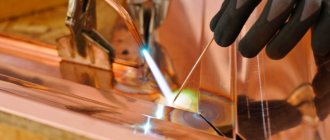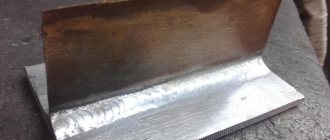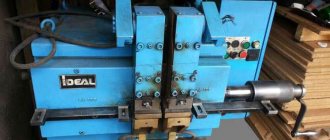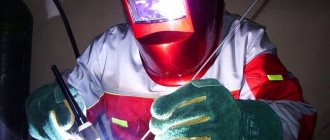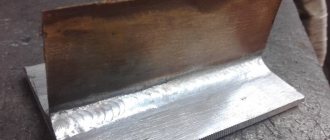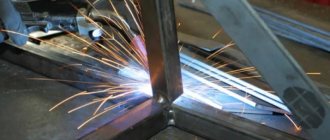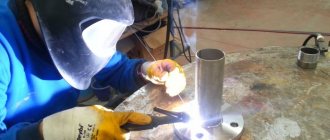Copper wires are more practical than aluminum wires; they are often used for wiring in private homes and laid when renovating apartments. Several ways of designing cable joints are allowed: they are secured with terminals or soldering. Crimping or compression of the twist is allowed, but the most reliable connection is formed by molten copper. To weld copper wires on a line or in a distribution box, spot technology is used. It is necessary to melt the twist to a homogeneous structure so that the resistance in the circuit does not increase. This is done for fire safety.
Features of welding copper wires
Copper melts well and is quickly saturated with hydrogen and oxidizes in the molten state. The melting point of copper alloys is no more than 1000°C. To protect the metal when welding copper parts, argon or carbon dioxide is used, but welding wires in a protective atmosphere is not economically feasible. For welding copper cables, conventional machines are used that generate direct or high-frequency alternating current and voltage from 15 to 30 V.
It is desirable that the operating current be regulated; to twist one core with a cross-section of 1.5 mm2, a current of 70 A is required; to connect three wires, the amperage will need to be increased to 90–100 A. To install copper wiring in a house with the connection of powerful electrical equipment, it is necessary to choose welding machines up to 120 A. If there is no optimal current, the arc will be interrupted and the electrode will begin to stick.
Welding copper and its alloys: technology
Before you start welding copper and its alloys, you must carefully prepare the product . Measured blanks are cut using a grinder, lathe or milling machine. For copper with a thickness of 6-18 millimeters, you need to prepare the edges. They should be V- or X-shaped. (For large volumes, it would be advisable to purchase an edger-beveler.)
Before starting work, the seams are thoroughly cleaned of contamination and oxidation. For copper welding to be successful, it is necessary to protect the bath from exposure to oxygen. For this, it is recommended to use electrode wire, which must be alloyed with aluminum and phosphorus. In some cases it is necessary to heat the copper .
It connects well when working with consumable electrodes. It is important to know that the length of the arc should be 4-5 millimeters. Using pulsed-arc welding technology in argon, you can make any types of seams, even ceiling ones, and weld very thin metal. It is recommended to place padding elements under it.
Soldering or welding copper wires - which is better?
The simplest and most effective soldering method is to immerse the contact point in molten solder. For small circuits this method is suitable. But it is not suitable for installing lines made of copper wires. Soldering with tin solders by weight requires skill; beginners cannot cope with such work, and there is a high risk of injury. Connecting wires with your own hands using contact welding is much safer.
Another advantage of welding is that the chemical composition of the wires does not change, and no solder particles get into the alloy. The electrical conductivity of the copper cable at the point of twisting does not change. Welding is faster than soldering; there is no need to pre-tin the contacts or select a soldering iron according to the power of the cable size. There are multi-core cords that cannot be soldered.
Welding has the only drawback: if you do not have the skills, you can damage the integrity of the insulation of the copper wire.
What you need to know about electrodes used for welding copper parts
To ensure a high quality weld, it is recommended to use electrodes coated with a special compound. Such a coating is necessary for the production of slag formed with metal oxides. It will prevent air from coming into contact with the weld. The coating fills the voids formed during welding of parts due to burnout of components and subsequently introduces new components into the seam. This coating contributes to better stability of the electric arc. The slag layer produced by this coating will slow down the cooling of the molten copper, causing more gases to escape from the weld.
Electrodes used in the welding process are divided into two types:
- melting - wire made of copper, steel, aluminum, cast iron is used for their production;
- non-melting - synthetic graphite and electrical coal are used for their production.
When choosing electrodes, you need to look at their color:
- yellow electrodes are intended for samples made of heat-resistant, corrosion-resistant steels;
- red - used for electric arc welding of copper products;
- gray – for blanks made of non-ferrous metals;
- blue - designed for connecting heat-resistant components.
Technology for welding strands of copper wires
The connection consists of melting the welded conductors with an arc when passing current, the clamping device compacts the structure of the diffuse layer. It is worth considering the process of welding strands of copper conductors in more detail. Step-by-step instruction:
- The ends of the cable to be connected are cleaned and the insulation is removed at a distance of up to 7 cm so that the wiring is not damaged during operation.
- The cores or threads are folded in parallel, they must be tightly twisted together, the type of twisting does not matter, but when axially joining in the direction of the conductors to each other, it is more difficult to weld the twist.
- The length of the twist should reach 5 cm, excess fibers are cut off. The wires are placed between the contacts or in a homemade clamping device at a distance of 2–3 cm from the edge.
- After touching the conductors with the electrode, an electric arc occurs; it is held for no more than 2–3 seconds, depending on the thickness of the conductors.
- The copper is melted in the clamping device, creating a strong connection.
- The cooled connected conductors are wrapped with insulating tape or heat-shrinkable film is put on it.
How to cook copper: methods
For successful and high-quality copper welding, inverters, semi-automatic machines, gas machines, and argon machines are most often used. Manual, semi-automatic and automatic welding of cuprum and its connections can be performed with consumable and non-consumable electrodes. To work with copper and steel, automatic arc technology and flux are used.
The electroslag method is recommended for joining products with a thickness of 30-55 millimeters. Using an inverter, you can use a carbon electrode, for example, ESAB OK Carbon, Weldline CARBONAIR PLUS . The store offers a wide selection of manufacturers. Welding copper with a graphite type of electrode has proven itself to be excellent. Below are several subheadings that provide more detailed descriptions of the best methods for welding copper and its alloys.
Inverter
You can select the electrodes most suitable for copper welding using inverters by visiting the corresponding section of the website. The recommended brand is Komsomolets 100. The inverter is designed to create a constant voltage, current of reverse or direct polarity. You need to work with a short break. Weld sections of 30-40 millimeters, after which they should cool naturally. The angle of inclination of the electrode should be 10-20 degrees.
Semi-automatic
When working semi-automatically, welding is carried out with copper wire; although it is thin, it is of very high quality and allows you to achieve good results. If the metal thickness is more than 6 millimeters, then it is recommended to prepare the edges with a grinder or chamfer. They should be V-shaped with a blunting of up to 4 millimeters. To ensure that the seam is not porous, welding is performed without transverse vibrations.
When working on a semi-automatic machine, you can use M2 wire with a thickness of 2 mm. Recommended voltage 30 V, 300 A. Work is done with transverse movements. In this case, flux K-13, AN26, wire M1-3 can be used. The strength of a copper weld made on a semi-automatic machine is not inferior in terms of performance to the base metal.
Argon
Argon serves as an excellent protective agent. Tungsten types of electrodes are used in the work. The role of the additive is performed by the wire. The work is carried out on direct current of reverse polarity. Thin copper products are connected without heating. Welding is recommended to be done from right to left. It is necessary to maintain an inclination angle of 90 degrees for the electrode and 15 degrees for the rod. Depending on the thickness of the metal, gas consumption ranges from 7-18 liters per minute. Welding current is set from 80 to 500 amperes.
Gas welding
In order for the weld to be strong and of high quality when gas welding copper, it is necessary to monitor gas consumption.
If the copper is thinner than 10 mm, 150 liters per hour of work will be enough, and if it is thicker, then 200 liters will be required. Welding must be done quickly , preferably without stopping, which will avoid the appearance of defects and cracks.
The filler material must melt before the base material. If the workpiece is thicker than 10 millimeters, then two burners can be used. The technology involves the use of fluxes. They contain boron. Alloying of the metal and its deoxidation using filler wire are allowed. The method is also suitable for joining copper alloys. It is important to know that the filler wire must be identical in composition to the base metal being welded .
Video
You can watch a short video that clearly shows the process close-up.
https://youtu.be/7_k6hZ0SyPo
[ads-pc-2][ads-mob-2]
Carbon electrode
Copper welding with a graphite electrode is common; a carbon analogue is often used. There are different methods for doing it. The arc can burn immediately between a pair of electrodes. She can be independent. It can be ignited between the electrode and the workpiece being welded. The technology is similar to gas welding. BrKMts3-1 wire is often used. Work may be performed outdoors. Connecting copper with a carbon electrode will fully meet the requirements for mechanical properties.
Carbon electrode inverter
Carbon electrodes ESAB ARCAIR
Carbon electrodes melt at a temperature three times higher than the copper they weld. Their consumption when operating an inverter is small. They heat up instantly. The carbon rods melt at a small current. To work with them you need to have experience. The resulting seam is usually distinguished by its quality, good oxidation resistance, density and strength. The angle of inclination of the rod should be up to 30 degrees. The current is set in the range of 35-130 amperes, which depends on the thickness of the copper. An inverter and carbon electrodes can be used to connect wires and twists. Such devices are light and convenient.
Welding nichrome with copper
Welding nichrome with copper with a carbon electrode allows you to achieve good results. The arc will burn well and steadily , its length reaches 30-50 mm. The electrode does not melt, but its end heats up to a high temperature. It produces a powerful thermionic reaction, which gives it the ability to burn stably even at a current of 5-10 A. The carbon type of the electrode slowly evaporates when working with copper and nichrome. It practically does not stick, which makes the work much easier.
Carbon welding at home
Welding copper with carbon electrodes at home is possible using a simple, inexpensive inverter. It can be powered from a regular network. He is not picky about conditions. Carbon electrodes are affordable for everyone. With their help, you can connect wires and seal holes in a car radiator. To learn how to use them, a non-professional can only read a few tips and watch videos.
[ads-pc-3][ads-mob-3]
Selecting Electrodes
The arc is ignited with a carbon rod or a copper-plated graphite electrode, also called a “graphite pencil”. The arc of a black carbon rod is higher than that of a gray “graphite pencil”; the consumption of electrodes is small.
If there are no carbon electrodes, craftsmen use graphite cores of AA batteries.
When welding cable joints, it is necessary to take care of individual protection against electric shock; do not neglect grounding. It's best to keep a fire extinguisher handy.
Copper Welding Machine
Quality welding machines for copper:
- – semi-automatic and automatic machines;
- – TIG – devices;
- – inverters.
Popular models are produced by TESLA, SPETSELECTROMASH, ESAB.
BUDDY TIG 160 from ESAB (pictured on the right) has two and four stroke torch firing modes. It can be used to join stainless steel and most other types of metals. It is compatible with almost any generator.
RENEGADE ES 300i ESAB inverter stores several welding parameters in its memory. Automatically sets the best starting parameters based on the configured current. It is lightweight but has high power.
Inverter machines allow you to weld copper rods; they generate a current of 60-110 amperes. For them you need to buy copper/carbon electrodes. HUNTER company produces semi-professional models, for example, MMA 257D, designed for continuous operation for two hours.
TESLA is known for reliable devices such as MMA 265, 275, 255. They have a non-contact arc excitation function. They connect to a regular household network without any problems. They are convenient for welding copper and its alloys, non-ferrous metals.
For welding with electrodes
Pulse-arc welding of copper plates is possible with tungsten electrodes in an argon atmosphere using an Orion 150s or 250s . They are lightweight and allow you to weld copper efficiently and reliably. The inverter welding device Resanta SAI-220 PN can be connected to a network with a voltage of 140-220 volts. It is easy to move with, it is equipped with a forced cooling system, so it does not overheat.
For wire welding
To perform copper wire welding work, the semi-automatic inverter Energomash SA-97PA20 is used. It has a light weight of 13 kilograms. It allows you to work with wire of different thicknesses 0.6-0.9 mm.
Smooth material feeding is ensured by the Shyuan MIG/MMA-290 model at a speed of 2.5-13 meters per minute. The device makes it possible to use 1-5 kilogram cassettes and allows you to work with electrodes.
The inverter semi-automatic welding machine Soyuz SAS-97PA195 is characterized by the presence of a 60 Volt idle speed function. It has an operating voltage adjustment range of 15-23 volts. A wire of 0.8-1 mm is suitable for it. It has a light weight of 10 kilograms, it is comfortable and reliable.
Welding brass structures
Welding brass at home is a rather complicated procedure, since brass contains zinc, which evaporates when heated, as a result of which the product loses its original strength.
When carrying out welding work with brass samples, substances harmful to human health are released. With the use of argon, the procedure for joining brass is completed quite quickly - this is a major technological breakthrough in the field of metal processing.
Brass itself is an alloy with zinc. The technology for joining parts made of brass is considered difficult due to the evaporation of zinc at high temperatures; this chemical element instantly oxidizes, resulting in the formation of a toxic, refractory oxide. Therefore, welding of brass samples should be carried out in specially equipped places equipped with an exhaust hood; welders should work in respirators.
Basic requirements for welding brass
- Cleanliness of the process when using argon-arc welding. Before starting work, the products are thoroughly cleaned to a characteristic metallic shine on the surface.
- There should be no oxides on the surface of the parts being welded; if present, they must be removed. Nitric acid is used for this. After this cleaning is completed, the product is washed in hot water and then dried.
If it is necessary to join brass products with a thickness of more than 0.5 cm, argon arc welding is an ideal option. The electrode moves into the conductive zone of the torch, the edges of the metal sample being connected melt under the influence of the electric arc.
When welding parts with argon, a characteristic continuous crackling sound is felt, and the welding arc has an amazing color. This is all due to the presence of zinc in the alloy. Brass does not burn through during the joining process, nor does it fly off in separate pieces, as it melts. Experienced welders advise welding brass in separate sections and not melting it in a continuous layer. When the material melts completely, there is a possibility of burning through the metal.
If it is necessary to weld a crater, then it is recommended to gradually reduce the welding voltage, increase the length of the arc and subsequently move it away from the workpiece. In the process of such a connection, the seam is filled in full; roasting of the zinc leads to its evaporation, resulting in the formation of defects in the metal. To reduce the evaporation of this chemical element, it is necessary to increase the presence of oxygen in the flame and use filler materials alloyed with boron, aluminum, and silicon.
Advice! When connecting brass parts, carry out welding work outdoors, do not neglect safety requirements!
